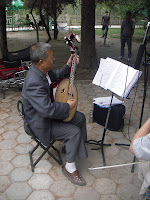“Socialism with Chinese characteristics” is a phrase that is frequently used to explain or identify the uniqueness of the Chinese economy. After traveling in different parts of China this summer, I wonder what Chinese characteristics are. Maybe that’s the point of the phrase—it’s open to multiple definitions and changing interpretations. I certainly felt that my travel, while rich and instructional, did more to confuse than to enlighten about Chinese characteristics.
I think the confusion begins with China’s geography. It’s a huge country that includes wet places and dry places, low places and high places, hot places and cold places, flat places and vertiginous places, barren places and fertile places. And I think Jackie and I saw a little bit of all these extremes when we traveled.
We began in the sea-level cities of east-central Jiangsu and Anhui Provinces and climbed to the over-3000-meter heights of Yunnan Province before descending to the below-sea-level depths of Xinjiang Province.
We also found ourselves sweating through dense steamy bamboo groves in some places and then searching for patches of shade in desolate deserts elsewhere.
We listened to a woman point out all the types of fruits and vegetables growing in the fields around the Li River where they have three growing seasons each year. This came after we cycled through rocky gorges where the only thing growing was sparse scrub that goats had a hard time surviving on.
We also found ourselves sweating through dense steamy bamboo groves in some places and then searching for patches of shade in desolate deserts elsewhere.
We listened to a woman point out all the types of fruits and vegetables growing in the fields around the Li River where they have three growing seasons each year. This came after we cycled through rocky gorges where the only thing growing was sparse scrub that goats had a hard time surviving on.
So, on a geographic level, saying “Chinese characteristics” means including nearly every known landform and ecosystem; not very helpful when it comes to specificity.
If I turn to the Chinese people and try to identify what is meant by “Chinese characteristics” on a human, ethnic level, I find the same confusion that springs from great difference and variety. Chinese people are tall and short, dark and fair, angular and voluptuous. They are scantily-clad hotties and burkha-obscured mysteries. They speak Chinese in its variations from Beijing-ese to Yunnan-ese and every –ese in between. They are everything from college-educated scholars, fine artists, and athletes to barely literate underclass members.
Much is made of the fact that most Chinese people are Han Chinese. But even more is made of the many ethnic groups. The Lonely Planet guide to China trumpets Yunnan as a destination because of its ethnic diversity. It says there the traveler gets “an extraordinary glimpse into China’s mixed salad of humanity.” One museum in Xinjiang had a whole floor devoted to an exhibit of the dozen or so ethnic groups that call the province their home. Of course this could be cynically regarded as a propaganda ploy in that province racked with ethnic violence.
My time and experiences all over China this summer got me no closer to understanding what is meant by “Chinese characteristics” in the Chinese people.
Of course every traveler needs food to fuel them as they take in the sights and human encounters along their journey. Jackie and I are no different. Well, maybe Jackie needs a little more steady supply of nourishment (to keep her blood sugar balanced) than I do. And maybe she shies away from some dishes (eel heads, grilled cartilage, and “old donkey” are acquired tastes that she is almost certain not to acquire) more than I do. So we had ample opportunity to find out what Chinese culinary characteristics are. I even had a copy of The Last Chinese Chef to supplement the knowledge gleaned from first-hand experience.
After seven weeks of responding to the question, “What should we eat tonight?” with the answer, “Chinese.” I don’t think I’m any closer to knowing what that really means. Besides the more questionable dishes mentioned above, “Chinese characteristics” at the dinner table could mean rice or noodles, bland or spicy, fish or meat, stir fried, steamed, boiled, or grilled. Even chopsticks, those devilish implements considered automatic at every Chinese meal, are not used in traditional Uighur dining. Fingers are good enough for them.
I didn’t go on vacation in a quest to find the answer to the question, “What are Chinese characteristics?” I did think I’d understand more about China after seeing so much of it. What stands out to me now is not how much more I understand but how much more there is to try to understand. The chief Chinese characteristic I have identified is the great variety that is meant by the word “Chinese”.




